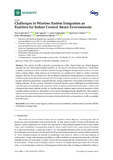Mostrar el registro sencillo del ítem
Challenges in wireless system integration as enablers for indoor context aware environments
| dc.creator | López Iturri, Peio | es_ES |
| dc.creator | Aguirre Gallego, Erik | es_ES |
| dc.creator | Azpilicueta Fernández de las Heras, Leyre | es_ES |
| dc.creator | Astrain Escola, José Javier | es_ES |
| dc.creator | Villadangos Alonso, Jesús | es_ES |
| dc.creator | Falcone Lanas, Francisco Javier | es_ES |
| dc.date.accessioned | 2017-11-15T09:28:43Z | |
| dc.date.available | 2017-11-15T09:28:43Z | |
| dc.date.issued | 2017 | |
| dc.identifier.issn | 1424-8220 | |
| dc.identifier.uri | https://hdl.handle.net/2454/26183 | |
| dc.description.abstract | The advent of fully interactive environments within Smart Cities and Smart Regions requires the use of multiple wireless systems. In the case of user-device interaction, which finds multiple applications such as Ambient Assisted Living, Intelligent Transportation Systems or Smart Grids, among others, large amount of transceivers are employed in order to achieve anytime, anyplace and any device connectivity. The resulting combination of heterogeneous wireless network exhibits fundamental limitations derived from Coverage/Capacity relations, as a function of required Quality of Service parameters, required bit rate, energy restrictions and adaptive modulation and coding schemes. In this context, inherent transceiver density poses challenges in overall system operation, given by multiple node operation which increases overall interference levels. In this work, a deterministic based analysis applied to variable density wireless sensor network operation within complex indoor scenarios is presented, as a function of topological node distribution. The extensive analysis derives interference characterizations, both for conventional transceivers as well as wearables, which provide relevant information in terms of individual node configuration as well as complete network layout. | en |
| dc.description.sponsorship | This work was supported by the Spanish Ministry of Economy and Competiveness under the Research Grant TEC2013-45585-C2-1-R. | en |
| dc.format.extent | 24 p. | |
| dc.format.mimetype | application/pdf | en |
| dc.language.iso | eng | en |
| dc.publisher | MDPI | en |
| dc.relation.ispartof | Sensors 2017, 17(7), 1616 | en |
| dc.rights | © 2017 by the authors. Licensee MDPI, Basel, Switzerland. This article is an open access article distributed under the terms and conditions of the Creative Commons Attribution (CC BY) license. | en |
| dc.rights.uri | https://creativecommons.org/licenses/by/4.0/ | |
| dc.subject | Smart cities | en |
| dc.subject | Smart regions | en |
| dc.subject | Context aware environments | en |
| dc.subject | Wireless sensor networks (WSN) | en |
| dc.subject | Interference management | en |
| dc.title | Challenges in wireless system integration as enablers for indoor context aware environments | en |
| dc.type | Artículo / Artikulua | es |
| dc.type | info:eu-repo/semantics/article | en |
| dc.contributor.department | Ingeniería Eléctrica y Electrónica | es_ES |
| dc.contributor.department | Ingeniaritza Elektrikoa eta Elektronikoa | eu |
| dc.contributor.department | Ingeniería Matemática e Informática | es_ES |
| dc.contributor.department | Matematika eta Informatika Ingeniaritza | eu |
| dc.contributor.department | Institute of Smart Cities - ISC | es_ES |
| dc.rights.accessRights | Acceso abierto / Sarbide irekia | es |
| dc.rights.accessRights | info:eu-repo/semantics/openAccess | en |
| dc.identifier.doi | 10.3390/s17071616 | |
| dc.relation.projectID | info:eu-repo/grantAgreement/MINECO//TEC2013-45585-C2-1-R/ES/ | en |
| dc.relation.publisherversion | https://dx.doi.org/10.3390/s17071616 | |
| dc.type.version | Versión publicada / Argitaratu den bertsioa | es |
| dc.type.version | info:eu-repo/semantics/publishedVersion | en |



